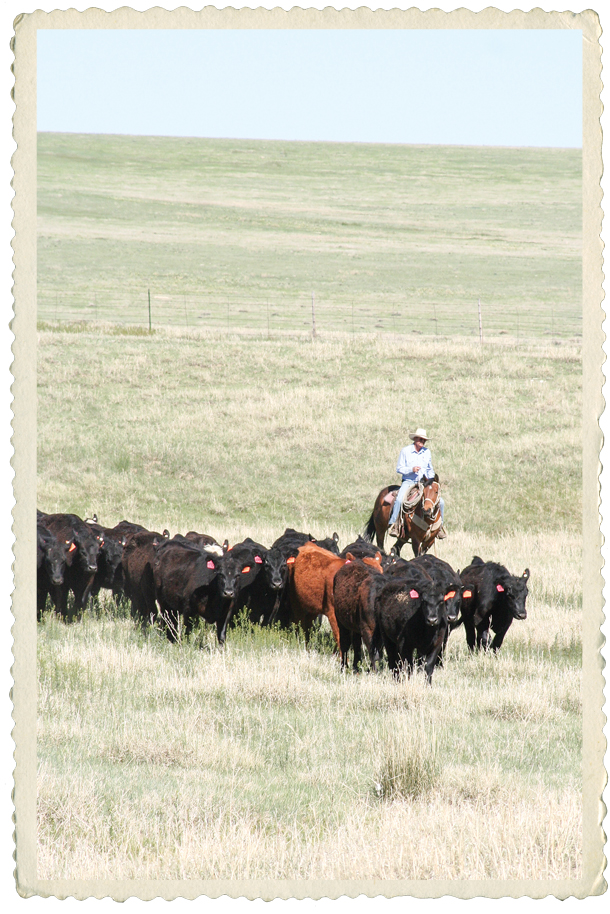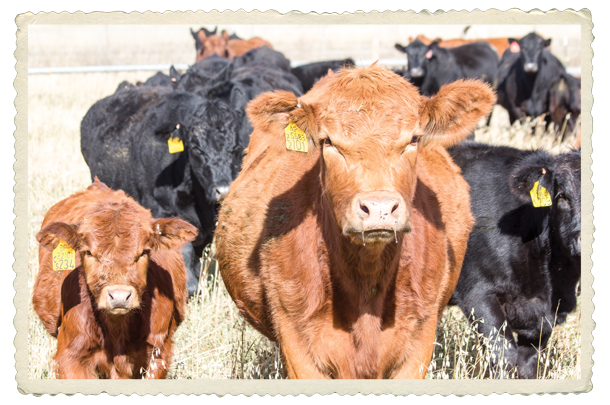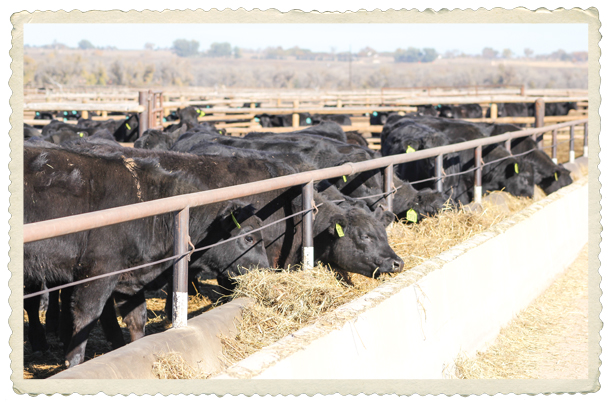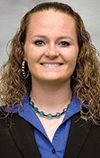The cattle industry is very diverse – from the cow-calf operator to feeders and processors. Very few people have all of the resources they need in a small area, but for producers in northern Colorado, their needs are met. The region of northern Colorado is not clearly defined but is generally defined as the area in the northeast quarter of the state. The largest county in this area is Weld County and is king when it comes to agriculture and cattle.
According to the 2012 Census of Agriculture, Weld County has the third-largest number of cattle and calves of all counties in the country, reported at 501,556 head. The value of sales in this area from cattle and calves is $1.04 billion, also ranked third in the country.
Cow-calf production
Northern Colorado is home to a large number of cow-calf producers. One producer in this area is Colorado Cattlewomen’s President Sallie Miller.
Miller owns Croissant Red Angus along with her husband, Kevin, and her parents, Larry and Jean Croissant. They are located in Briggsdale, Colorado, where they have been for 20 years. They currently manage 200 pairs and a small feedlot.
The Millers’ main focus on their registered herd is to produce bulls that feature calving ease, fertility, carcass quality and disposition. “If they have any sort of attitude, they don’t get kept. They need to be very maternal,” she says.
They want to produce cattle that can thrive, which is an important part of many cow-calf producers in this area. Part of the northern Colorado area includes the Pawnee National Grasslands, which includes about 193,000 acres – of which nearly all is grazed under federal grazing permits.
“We raise range cattle. My husband always says they need to be able to get fat on cardboard. We don’t have a lot of grass, but they need to be able to survive on what we have,” Miller states.

Although they do not have permits for the grassland, the type of range they are on is the same, and Miller estimates they need 40 to 45 acres per pair, and they still feed four to six months of the year, depending on snowfall.
“It’s good range. We have enough domestic water for the stock wells but not enough to irrigate anything. If the range is managed right, it’s good ground. It isn’t suitable for houses or cropland. We have a pretty decent climate. It really suits the cows,” Miller explains.
They hold a bull sale each year in March to sell their yearlings. The bulls they choose not to sell and the heifers that don’t meet their standards are then backgrounded and finished in their small feedyard. They also finish out some for other customers.
The feed for their feedyard has to be purchased, but most of it is purchased locally in the northern Colorado area. They are able to use some dried distillers grains from the local breweries and beet pulp from the sugar beet factory in Fort Morgan, Colorado.
These cattle are then processed locally, and data is collected when it can be. “Any of them that we can get data back on, we get that data and submit it to the Red Angus Association for EPD improvement,” she says.
Miller enjoys raising cattle in this area. “I enjoy being able to be out there with the cows, knowing that I’m producing something that’s feeding people. In the meantime, those animals have a really good life. Being able to get out there with the cattle, you really do get to see what you are making,” she states.
Sale barns
For the majority of cow-calf producers, once cattle are weaned, they then need a place to go and a way to be marketed. Northern Colorado has several sale barns, which is a big advantage for both producers and for feeders.
“On cow-calf operations, more than half of producers sell their calves in a sale barn. They can’t put together a semi-load, and sales yards allow the buyers there to do that."
"Producers have a close place to market those cattle with these sale barns,” says Jason Ahola, assistant professor of beef management systems at Colorado State University.
The sale barns also provide a place for producers to market their cull cows. “One of the things we don’t have is a larger packer of cull cows. A lot of those cattle have to travel a longer distance, such as to Nebraska, Minnesota or Arizona. The sale barn provides the service of being able to offer cull cow buyers groups of cows,” Ahola says.
Feeders
In addition to having a robust cow-calf section, this area is also home to several large feedlots, all owned by JBS Five Rivers. They have three feedlots in this area. The Gilcrest lot, located in LaSalle, Colorado, has a 69,000 capacity. The Kuner yard, located in Kersey, Colorado, can house 98,000 head. Finally, the Yuma lot, located in Yuma, Colorado, has a 110,000-head capacity.
“There are several different advantages to having the feeders here. One of them is the fact that there is a big buyer of calves and feeder cattle right in our backyard. It helps the market and adds competition to people wanting to buy feeder cattle,” states Ahola.
He continues, “It allows us to have a major packing plant here. Both industries, feeders and packers, make sure they both stay here, as they depend on each other.”
Having a large number of cow-calf producers in the area, as well as a large number of dairies, is an advantage to feeders. “Colorado also has robust cow-calf and stocker sectors, so sourcing cattle from around the state into northern Colorado feedyards is another link in the supply chain that keeps costs down,” says Libby Bigler, Colorado Beef Quality Assurance coordinator.
Many different breeds are fed out in this area, including Holsteins. Northern Colorado is home to many dairies. “A lot of the steers from the dairies are developed on calf ranches and then head into the feedyards. That’s another supply to the feedyard, and it adds value to the dairy calves as well,” Ahola says.

In addition to these large feedyards, there are many smaller feedlot operators in the area. Jennifer Musick, who owns a small feedlot in Mead, Colorado, with her sister, feeds 45 to 50 cattle every year. She sources her cattle locally.
“Some are home-raised, and then I periodically purchase small groups of six to 10 throughout the year to make sure I have enough in each weight range to have beef ready almost all the time,” she explains.
One advantage to this area for feeding cattle is in feed. Although it is not the Corn Belt, there are a lot of corn and corn products produced in this area. The biggest feed source in this area is corn silage, with 56,593 acres in silage just in Weld County, ranking this county sixth overall in the country.
“We often talk about the country’s Corn Belt and its importance in cattle feeding in the U.S. I’d consider northern Colorado our state’s own ‘corn belt’ region,” states Bigler. “As such, it is a great place for producers to capitalize on the cattle feeding business."
"Access to corn is abundant, and the region boasts several processing facilities which allow feeders to minimize costs associated with transporting both corn and cattle.”
Having a large number of cattle on feed that are then processed produces checkoff dollars as well, which is a big advantage to Colorado.
“One unique thing is that we get the checkoff dollars on all of those cattle that go to slaughter from those yards. Roughly half-a-million dollars a year is split between the state beef council and the national beef council. It allows us to do more promotion of beef here,” Ahola explains.
Processors
One of the largest cattle processors in the world, JBS Swift, has their U.S. headquarters in Greeley, Colorado, which is also in Weld County.

JBS has a cattle plant here as well as a lamb plant. It is estimated that JBS Swift processes approximately 5,400 head of cattle every day, resulting in 3.3 million pounds of meat each year. The plant provides jobs for thousands of residents as well. JBS Swift estimates that 30 percent of this plant’s production is exports to 20 different countries, including Hong Kong, Korea and Japan.
In addition to these two plants, there is also a large Cargill plant in Fort Morgan, Colorado. This facility processes 4,800 head a day, or 1.2 million per year.
Having cattle in feedyards near the plants is an advantage for the packers. “There is very low cost in getting cattle from a feedyard to a packer when they are so close. If the plants weren’t around, the feedyards might not be around, and the cattle would have to be shipped farther,” states Ahola. He adds, “It creates better efficiency since they are not shipping all over the country.”
There are several smaller processing facilities as well, which are USDA-inspected and offer a butcher shop-type atmosphere for customers. “Smaller packers help some of the local-branded beef programs be successful. You are not going to go to a larger processor to process 1,000 head a year,” says Ahola.
Musick markets half of her cattle to these small packers in the area, and all of them are processed there. “I deliver to the packer. I market probably 50 percent in packer purchases and 50 percent to my customer base,” she says.
Having these local small packers is a big benefit to Musick. “They are incredible and definitely very instrumental in making my business work. The sources they have to sell beef to add an extra outlet for marketing,” she says.
She continues, “Our processor is USDA-inspected, and all of my customers are very fond of their excellent and high-quality packing. They’re pretty close by, and we are keeping all the meat on a smaller local scale.”
Industry resources
Another big advantage to this area is the abundance of industry resources. This area is home to Colorado State University, which includes the veterinary teaching hospital, the Agricultural Research, Development and Education Center, where a lot of beef cattle research is done, the Department of Animal Science and Department of Agricultural and Resource Economics.
The Colorado Livestock Association is located in Greeley as well, and the Colorado Cattlemen’s and Cattlewomen’s associations are very active.
While not in northern Colorado, two large industry leaders, the National Cattlemen’s Beef Association and the United States Meat Export Federation, are just down the road in Denver. Several breed associations also claim areas in and around Denver as home.
Education opportunities
Having so many different facets of the beef industry, from birth to processing, helps the industry in Colorado. “In a day and age where consumers want more information about their food, transparency has become a critical part of the beef marketing message. Through analyzing purchasing decisions, we know that consumers are more and more concerned with things like where and how their beef was raised,” explains Bigler.
She continues, “Having all facets of the beef supply chain represented in our state is a prime opportunity for our industry to open its doors to consumers and provide them with the transparency they are looking for.”
One of the biggest opportunities producers in this area have to educate consumers is at the National Western Stock Show, held every January in Denver, Colorado. The Colorado Beef Booth allows producers to teach attendees about the beef industry.
“The beef industry has a great story to tell, whether it be BQA standards that we practice to ensure safe, healthy and wholesome beef products; our responsibility as stewards of the land; or about food safety and animal welfare initiatives in the packing sector,” says Bigler.
This education is important because it helps to teach local consumers about the value of the beef industry to the state. “Colorado represents folks who can tell all of these stories, and this gives us an opportunity to be the conduit between the growing urban sector and the real farmers, ranchers and processors who actually move beef from gate to plate."
"This really gives us a chance to tell our story all the way down the supply chain and to ensure that beef remains at the center of the table,” Bigler says.
The wide range of producers in the area helps northern Colorado to be a staple in the beef industry, both in the state and nationwide. “Colorado beef production is at the top. We are one of few states that has every segment of the beef industry, and we have that in northern Colorado."
"We have a large representation of all of the sectors, which makes us a major player at the national level,” Ahola states. ![]()
Robyn Scherer-Carlson is a freelance writer based in Colorado.
PHOTO 1: Angus cows graze the far west amber terrain of the Weaver Ranch outside of Fort Collins, Colorado. Photo by David Cooper.
PHOTO 2: Northern Colorado has a lot of open range land, and many cow-calf producers utilize this land. Photo by Robyn Scherer-Carlson.
PHOTO 3: A cow-calf pair of Simmental and Angus crosses graze at the Altenburg Super Baldy Ranch in Fort Collins, Colorado. Photo by David Cooper.
PHOTO 4: Cattle are being finished at the JBS Five Rivers feedlot in Gilcrest, Colorado. Photo by Robyn Scherer-Carlson.







